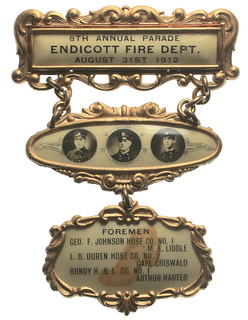
PREV ARTICLE
NEXT ARTICLE
FULL ISSUE
PREV FULL ISSUE
NUMISMAGRAM MEDAL SELECTIONS: SEPTEMBER 2020Numismagram's Jeremy Bostwick forwarded along these highlights from among the selections recently added to his website at the beginning of the month. In addition to these new art medals and plaques, he will also be featuring an assortment of medallic works from the hand of Swedish sculptor-engraver Erik Lindberg (famous for his design of the Nobel Prize award medals and related nominating committee medals) later this month, so stay tuned to numismagram.com/inventory for all of these new additions. -Editor
Banská Štiavnica Mining Academy Medal 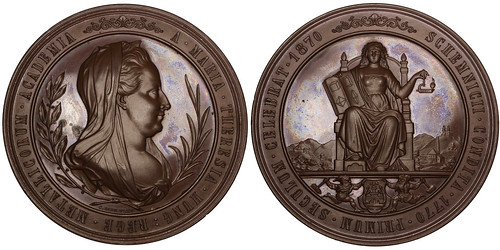
101205 | AUSTRIA-HUNGARY. Mining Academy bronze Medal. Issued 1870. Commemorating the 100th anniversary of the academy in Banská Štiavnica (69mm, 107.39 g, 12h). By C. Radnitzky. A • MARIA • THERESIA • HUNG : REGE • METALLICORUM • ACADEMIA, diademed, veiled, and draped bust of Maria Theresia right between wreath of palm frond and laurel branch / SCHEMNICII • CONDITA • 1770 • PRIMUM • SECULUM • CELEBRAT • , Hungaria seated facing on throne, holding miner's lamp and open mineralogy book; countryside with factories and mines in background; in exergue, coat-of-arms with dwarven supporters. Edge: Plain. Hauser 1645; Serfas 305; Montenuovo –; Wurzbach 6044; Preussag Coll. II, 1631. Gem Mint State. Glossy chocolate brown surfaces, with an intense degree of radiating luster; a few light spots on the obverse are noted for completeness. $325. A town tied to mining since antiquity, Banská Štiavnica was mentioned by Roman authors for her silver ore mined there by the Celts, and was the main producer of silver and gold for the Kingdom of Hungary during the Middle Ages. In 1627, it became one of the first places where gunpowder was used for blasting. This medal commemorates the centennial of an academy established there in 1770 in the field of mineralogy.
Dwarven supporters! A beautiful and interesting piece. -Editor
To read the complete item description, see:
Ernst Otto Theodor Westerlund Medal 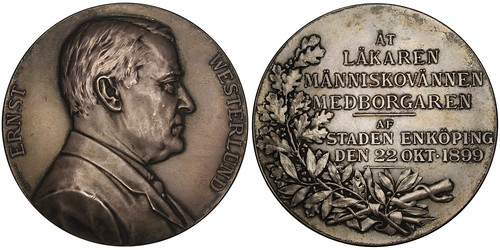
101233 | SWEDEN. Ernst Otto Theodor Westerlund silver Medal. Issued 1899. Commemorating the 60th birthday of the physician (56mm, 76.75 g, 12h). By A. Lindberg. ERNST WESTERLUND, bust right / ÅT / LÄKAREN / MÄNNISKOVÄNNEN / MEDBORGAREN / AF / STADEN ENKÖPING / DEN 22 OKT • 1899 in seven lines; oak and laurel branch curled to left, with serpent-entwined staff below. Edge: Plain. Brettauer –; Storer 3768. Choice Mint State. Pleasingly toned on the obverse, with a somewhat lighter nature on the reverse, and attractively matte throughout. $295. Born in 1839 in Öregrund, Ernst Westerlund was thrust into the role of provider for his household at a very young age due to the early deaths of his father and siblings. He studied at Uppsala University, where he received his degree in medicine in 1867. Following the death of the city doctor in Enköping in that year, Westerlund took over the role, quickly developing a name as a skillful gynecologist as well as a neurologist. The name of "Enköpingsdoktorn" was bestowed upon him, and he continued to receive patients not only from around Sweden, but from Finland, Norway, Denmark, and even Russia. One such Russian patient was Count Lev Tolstoy, son of the famous "War and Peace" author by the same name. While under the care of Westerlund, he fell in love with the latter's daughter, Dorothea (Dora), marrying her in 1896 and ultimately settling there during the early years of World War II. Westerlund continued his practice in Enköping until his death in 1924 at the age of 84, having served the community for nearly 57 years.
To read the complete item description, see:
Jan Kolda Medal 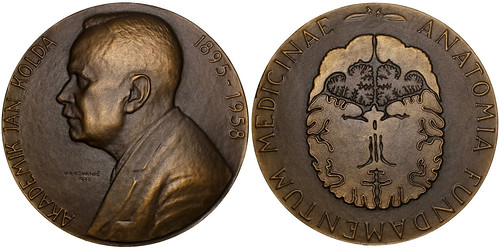
101249 | CZECHOSLOVAKIA. Jan Kolda bronze Medal. Issued 1972. Commemorating the life of the comparative anatomist and professor (60mm, 86.44 g, 12h). By V. A. Kovanic. AKADEMIK JAN KOLDA 1895–1958, bust left / ANATOMIA FUNDAMENTUM MEDICINAE, view of a human brain from the top. Edge: Plain. Gem Mint State. Brown-bronze surfaces, with a great matte nature. Highly interesting anatomical type. $185. A comparative anatomist and professor, Jan Kolda passed away on 29 November 1958 in Doubravník. His lengthy career can be best summed up by fellow veterinarian and professor, Cenek Cervený, following Kolda's death: "The work he performed to the benefit of Czech and world-veterinary morphology, is enormous. He was an excellent university teacher, he compiled the first Czech textbook of veterinary anatomy, developed scientific activities on a wide basis and educated many successful followers. He built the Anatomical Institute and a magnificent anatomical museum. He laid solid foundations to Czechoslovak veterinary morphology."
A brainy piece. -Editor
To read the complete item description, see:
Johan August Wahlberg Medal 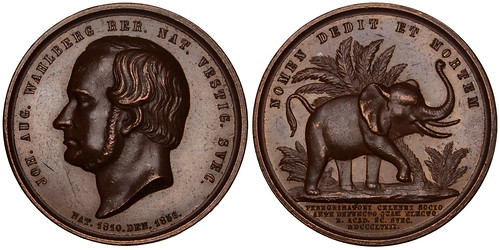
101218 | SWEDEN. Johan August Wahlberg bronze Medal. Issued 1858. Honoring the naturalist and explorer (31mm, 10.79 g, 12h). By L. Ahlborn. JOH AUG WAHLBERG RER NAT VESTIG SVEC, bare head left / NOMEN DEDIT ET MORTEM, elephant trumpeting right; in four lines in exergue, PEREGRINATORI CELEBRI SOCIO / ANTE DEFUNCTO QUAM ELECTO / R ACAD SC SVEC / MDCCCLVIII. Edge: Plain. Olsén 133; Laidlaw 0024. Mint State. Charming red-brown surfaces, with some brilliance in the fields and just a hint of rub on the high points. $225. A Swedish naturalist and explorer, Johan August Wahlberg graduated with a degree in chemistry from Uppsala University in 1829, and later in forestry and agronomy in 1834. Beginning in 1838, Wahlberg embarked upon an exploratory trip to southern Africa where he collected countless specimens of natural history to be sent back to Sweden for study. While in what is now Botswana, Wahlberg was tragically killed by a wounded elephant. As news of his death had not yet reached Sweden, he had, in the meantime, been elected to be a member of the Royal Swedish Academy of Sciences, making him the only member to have been elected posthumously.
Ironic combination of images, but a great elephant nonetheless. -Editor
To read the complete item description, see:
Endicott New York Firemen's Convention Badge Emerging as one of the "Triple Cities" in the Southern Tier of New York, Endicott was the final of these three triplets (the others being Binghamton and Johnson City) to be established, incorporated largely as a company town in 1906. The source of the village's early boom was shoes—namely, the Endicott-Johnson Shoe Company, which rapidly grew to become one of the largest shoe manufacturers in the nation, even supplying nearly all of the footwear for America's war efforts in World Wars I and II. "E-J" quickly became a highly sought-after employer on account of the "square deal" promoted by company president and partner, George F. Johnson. Employment, though piecemeal, offered medical benefits and the first 8-hour workday/40-hour workweek in the shoe industry. Additionally, activities and attractions for the workforce outside of the job were created, such as libraries, parks, pools, parades, and even company built homes. This badge was for the 8th annual parade for the association of firemen from the "tri-villages" of Endicott, Union, and Johnson City (then still known as Lestershire), with 1912 being the inaugural year for the creation of Endicott's fire department. Notable firefighting companies among the parade's foremen included the George F. Johnson Hose Co. No. 1 (named after the aforementioned G. F. Johnson), the L. D. Duren Hose Co. No. 2, and the Bundy Hook and Ladder Co. No. 1 (named for Harlow E. Bundy, a nearby resident of Binghamton who mass produced his brother's invention of the time clock and whose subsequent business—the Bundy Manufacturing Co.—was eventually amalgamated into what would become IBM). Adding even more local flair, a shoe—emblematic of Endicott itself at the time—is subtly displayed in the background.
Unusual, rarely-seen item, -Editor
To read the complete item description, see:

Wayne Homren, Editor The Numismatic Bibliomania Society is a non-profit organization promoting numismatic literature. See our web site at coinbooks.org. To submit items for publication in The E-Sylum, write to the Editor at this address: whomren@gmail.com To subscribe go to: https://my.binhost.com/lists/listinfo/esylum All Rights Reserved. NBS Home Page Contact the NBS webmaster 
|
